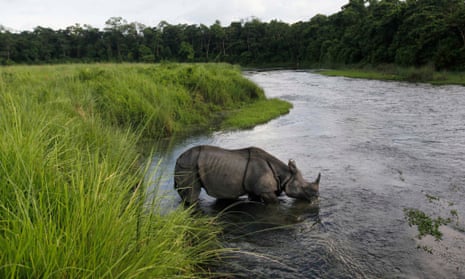A surge in the number of endangered rhinos has brought some cheer to earthquake-hit Nepal.
The country has seen a steady increase in the number of rhinos over the past 10 years, making the country a global example of how poachers can be defeated.
The country’s population of one-horned rhinos, one of the most endangered species in the world, now stands at 645, according to figures released this week.
Most are at the Chitwan National Park in the south-west of the country.
“At a time when the world is facing difficulties to protect and conserve the wildlife including rhinos, Nepal has seen an extraordinary improvement in wild life conservation,” said Diwakar Chapagain, an official at World Wildlife Fund.
“It is definitely a rare successful conservation story in the world, where park officials and the Nepalese army have managed to succeed in anti-poaching activities.”
In three of the past five years there has been no rhino poaching at all. In 2002, 37 rhinos were killed by poachers, leading many experts to express deep concern over the future of the one-horned rhino in the country. By 2005 the population stood at only 375. Since then, numbers have risen dramatically.
Poaching of greater one-horned rhinos for their horns continues to be a major problem and countries in Africa have had difficulty curbing the threat.
The animal is featured prominently on the red list of the International Union for Conservation of Nature.
The horn is used in traditional Asian medicines, primarily for the treatment of a variety of ailments including epilepsy, fevers and strokes.
Asian rhino horn is believed to be more effective than African horn, though neither has been medically proven.
“Wild animals such as tigers, rhinos, elephants and leopards have been regularly killed by poachers for their body parts and skin, which fetch thousands of dollars on the black market,” said Kamal Jung Kunwar, warden of the Chitwan National Park, which has large numbers of rhinos and tigers.
Chapagain said there are rumours in Vietnam that one-horned rhino can cure cancer. “It’s not true, yet the ignorance has increased the demand of the one-horned rhinos,” he said.
Key factors behind the increase in the number of rhinos have been tougher penalties for poaching, a streamlined judicial system dealing with the offence and the use of the military. Wildlife across Nepal suffered during the 10-year civil war, which ended in 2006.
“The Nepal army plays a key role in anti-poaching, normally one battalion of army [soldiers] is deployed in Chitwan National Park. That’s 1,100 men and more are added according to need,” said Kunwar. “There has been 24/7 patrolling going that has resulted into this success.”
The police have also been successful in breaking up poaching networks. Earlier this year a notorious poacher was arrested in Malaysia.
Close links with local communities have also been built up, with systems set up to ensure they receive around a third of the revenues derived from tourism for development projects.
The greater one-horned rhino has a single black horn and can weigh up to 2,500kgs. The horn is used for digging for roots. The most recent census took a month and involved 267 officials.
